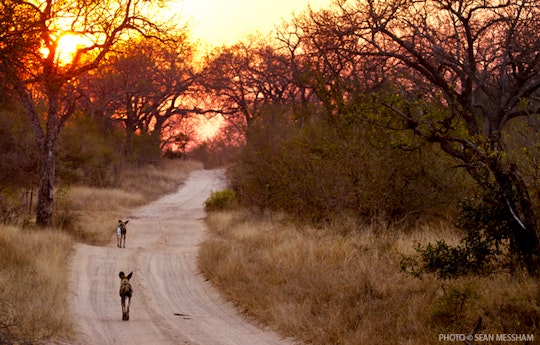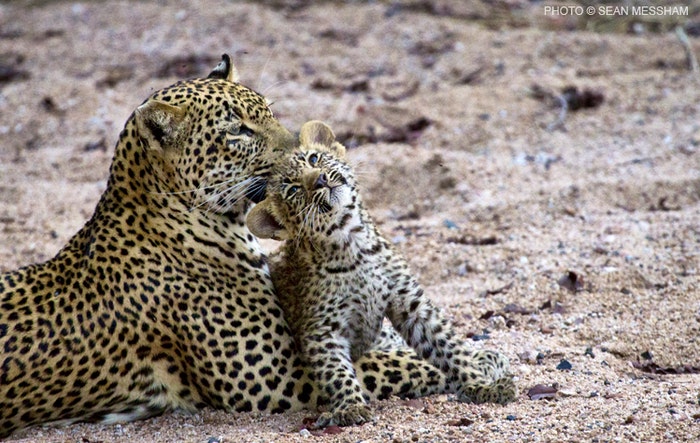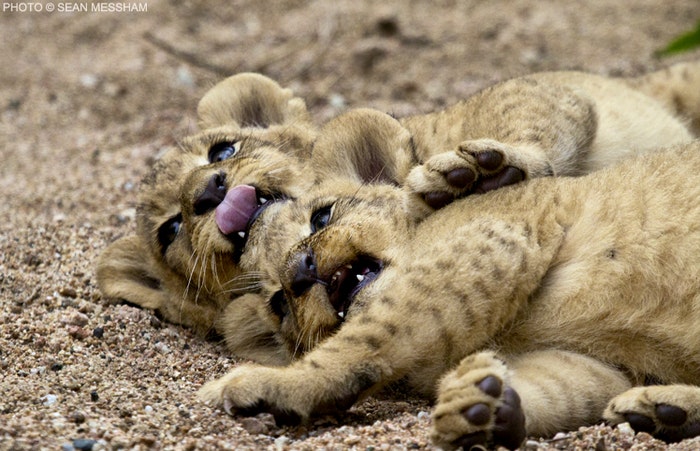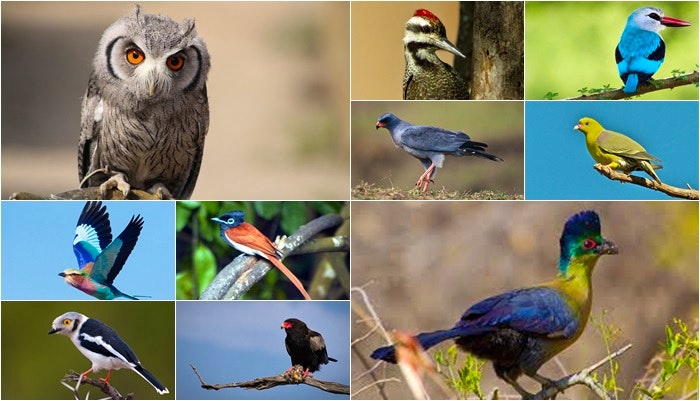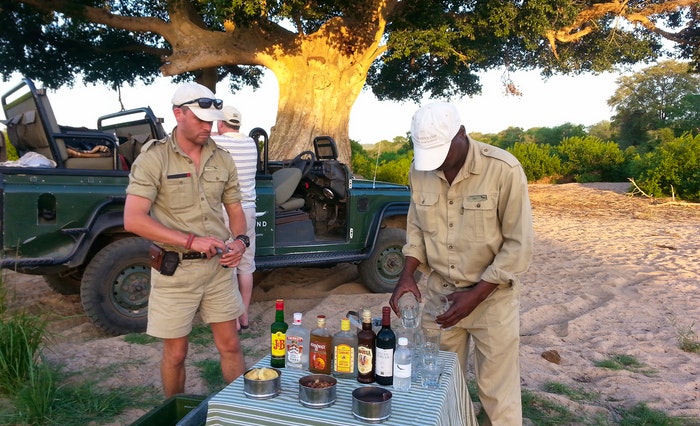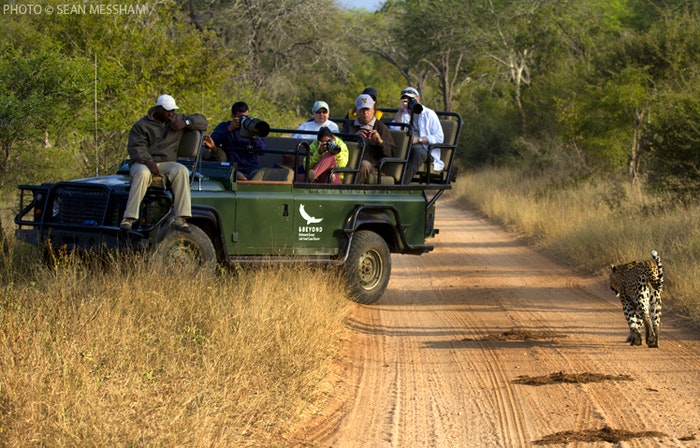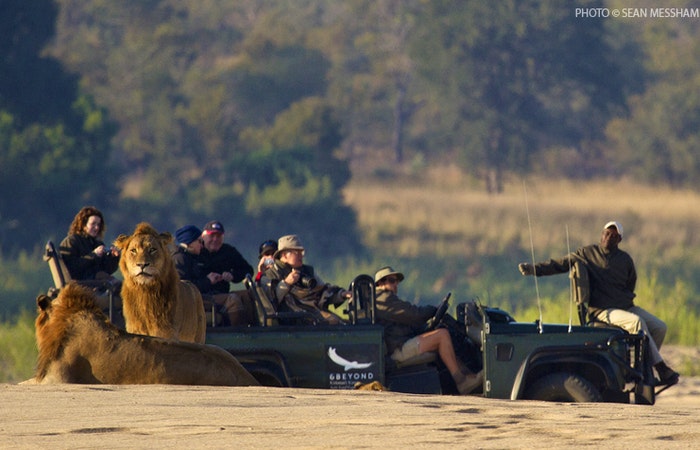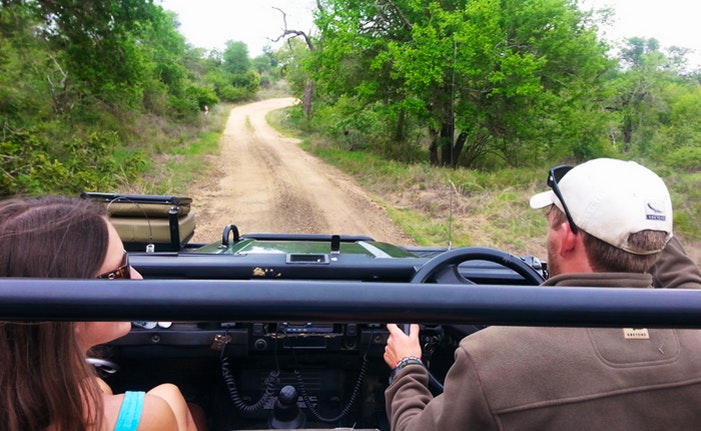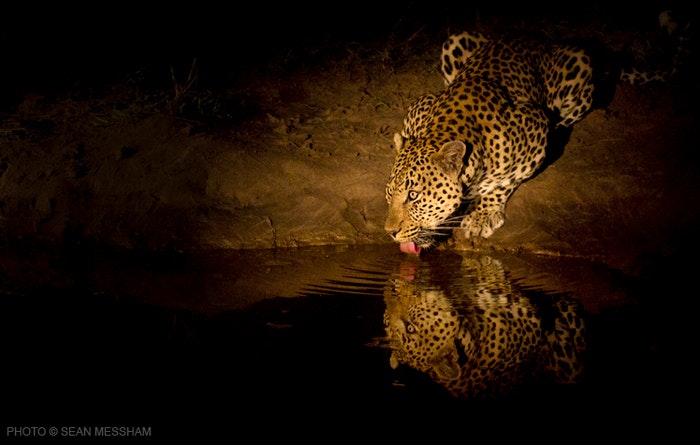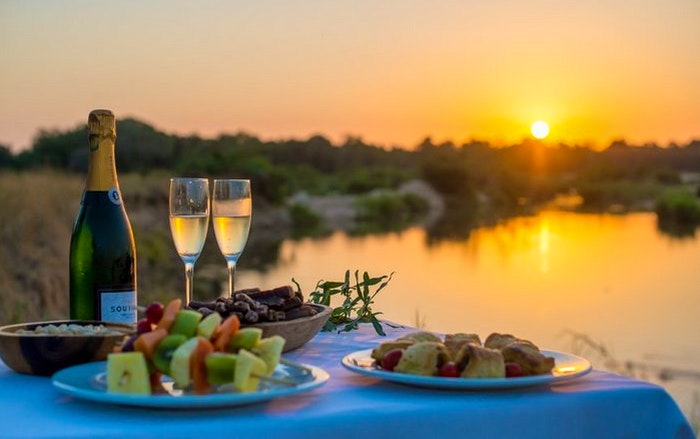Sabi Sand Game Reserve is an unfenced 65,000 hectare reserve bordering the Kruger National Park that offers the rare opportunity to track animals off-road. Heralded as the most famous private game reserve in South Africa, Sabi Sands offers extraordinarily close wildlife encounters, particularly of the elusive leopard. While people are not allowed to cross the boundary between Sabi Sands and Kruger, the animals are free to roam between the two reserves, so you get to see the best of both worlds.
What’s so special about Sabi Sands?
There’s something remarkable about driving straight through the bush when you spot a big cat – something you could never do in the Kruger. Ducking and diving from vicious branches adds to the thrill of the experience as your ranger and tracker work together to discover the animals on your checklist.
Sabi Sand Game Reserve, traversed by both the Sabi and Sand Rivers, is large enough that routes are not repetitive, yet small enough to allow a surprising concentration of wildlife. What’s so great about Sabi Sands is the animals’ complete trust in the rangers and vehicles that work here. I noticed an astonishing difference in the animals’ behaviour here compared to Kruger. We weren’t paid the slightest bit of attention as we indiscreetly followed them, crunching loudly over bushes and rocks. Elephants were the exception as we visited in summer when their herds were supplemented with several babies – resulting in a bit of an ominous head shake to warn us when we got too close. But most of the time you can get so close to the wildlife that you can almost touch them – worlds apart from Kruger where the animals disappeared the moment they heard us coming. There’s a standing joke in Sabi Sands that if any of the game act skittish and run away, they must be from Kruger.
My experience
When I visited Sabi Sands, I was a Big Five amateur. I’d been to Kruger and Hluhluwe-Imfolozi, but my experience included only a handful of elephants, a herd of buffalo, a few rhino, and a well-camouflaged lion and lioness mating in the bush about 4m away from me (and it didn’t help that I had forgotten my glasses). So I was excited to hear that Sabi Sands is a leopard spotting paradise.
We were lucky enough to enjoy 3 days at &Beyond Kirkman’s Kamp in Sabi Sands, a roughly 25 minute bush drive from Skukuza Airport. Prior to my visit I had given my ranger friend, Sean, a hard time about seeing leopards. He would nervously laugh and say, “We’ll see what the bush has in store for us”, but I don’t think even he imagined just how much the bush would show off for us on our first night.
We headed off with Joel, a trainee ranger, with an air of anticipation. We’d barely turned the corner from the camp when we spotted a giraffe delicately munching leaves from a tree.
The rest of the evening continued in the same vein: elephant, impala, elephant, white rhino, buffalo, hippo, elephant. It was getting dark when we heard a cryptic call over the radio that another ranger had located a male leopard! After crashing through the bushes, getting lost, and being redirected by the sound of another ranger’s vehicle, we finally made it to the leopard sighting. He was magnificent. With two cars following him unceremoniously through the bush, he didn’t even acknowledge our presence, nor did he increase his pace. We slowly followed him until it got too dark to see him.
I joked about the absurdity of spotting a lion and completing the Big Five on our first day. Ironically, we heard a call over the radio about an ngala spotting (this means lion in Shangaan). The next thing we knew, there was a lioness in the middle of the road stalking a herd of impala. We couldn’t believe our luck!
Much to our amazement, the next two days bettered the first. We spotted two more leopards, two lionesses with playful lion cubs, a ridiculous amount of impala and other antelope, an impish hyena, a white-tailed mongoose, several giraffe, a herd of elephants with their babies wallowing in a shallow mud bath, a lazy white rhino having a dip in a pool of water, and a hippo walking along the banks not far from our drinks stop. We even got close to spotting all of the Baby Five (that’s not really a thing, but let’s go with it) as we saw baby buffalo, lion cubs, a teenaged rhino, and impossibly small elephants. Although we got close to the bush where the leopard cubs were believed to be resting, we didn’t see them as the rangers aren’t allowed to approach cubs without their mother present until they are 6 months old.
On the last day, Sean asked whether we had any final requests for an animal we wanted to see. It was a hard question as we’d already seen so much that it almost felt greedy to ask for more. My request for male lions was answered by a nervous chuckle. Sure enough, the next day we spotted 3 male lions sunning themselves on the gravel road. It was only then that Sean revealed the reason for his “manly” giggle. There had been no sightings of lion coalitions in the reserve for a few days and he hadn’t expected to find any. Sabi Sands had spoilt us again.
What can you see?
Sabi Sands has a high animal density. You can spot the Big Five (leopard, lion, buffalo, rhino, and elephant), various antelope (impala, waterbuck, kudu, duiker, bushbuck, and nyala), as well as giraffe, warthog, baboon, zebra, civet, genet, mongoose, hyena, wild dogs, hippo, vervet monkey, crocodile, honey badger, and the occasional cheetah if you’re extremely lucky.
The 10 “Star birds”
Keep an eye out for the 10 “Star birds”. These visually appealing birds have been picked as part of an &Beyond initiative to get people excited about birding. The Star Birds (from left to right in the image above) include:
1. Scops owl
2. Bearded woodpecker
3. Woodlands kingfisher
4. Dark chanting goshawk
5. African green pigeon
6. Lilac-breasted roller
7. African paradise flycatcher
8. White-crested helmet-shrike
9. Bateleur
10. Purple-crested turaco
Game drives
Two game drives run each day – in the early morning and evening. They are done in open 4×4 safari vehicles and last roughly 4 hours. You’ll be designated both a ranger and a tracker who will attempt to track your favourite animals. Only 6 people are taken in each vehicle at a time. Both drives include a drinks stop in the bush (lodge dependent) where you can get out of your vehicle, stretch your legs, and enjoy some refreshments (tea, coffee, and hot chocolate mixed with Amarula in the morning, and a selection of alcoholic beverages in the evening). You can even have a gin and tonic with a slice of lemon on the side!
Rangers and trackers
&Beyond is renowned for having the most highly trained rangers and trackers on the continent. They have been through extensive training, so you’re promised the very best of the best. The main thing about every one of these guys is that they love what they do. And you can tell. It’s hard not to find their passion contagious.
The trackers are exceptional. I enjoyed watching Elvis who certainly has tracking skills embedded in his very bones, passed down from generation to generation. This kind of skill cannot be taught. He took cues from nature that we all take for granted, relying on smell, animal behaviour, trodden bushes, tracks in the sand, and an intangible (and rather uncanny) intuition.
Rangers on the radio – Learn the lingo!
All of the rangers keep in touch via radio, so that they can alert each other about any sightings. I enjoyed listening to the rangers’ communicating on the radio and deciphering their Shangaan code. Listen out for these clues:
- Ingwe – leopard
- Ngala – lion
- Mangwa – zebra
- Indlovu – elephant
- Inyathi – buffalo
- Mahlolwa – wild dog
- 100% – not a problem
The leopard and lion prides that live in Sabi Sands have all been given names. Hopefully you can spot the Charleston, Toulon, or Sand River lion coalitions; or the leopards called Schotia, Rollercoaster, and Xovonekela.
Getting there
By car
The drive from Johannesburg in a rental car or private car is roughly 450km.
By air
Scheduled flights are available from Cape Town and Johannesburg to Kruger/Mpumalanga International Airport, Skukuza Airport, and Hoedspruit Airport – convenient for those staying in northern Sabi Sands. Scheduled charter flights from OR Tambo International Airport serve almost all lodges on a daily basis.
Gates
- Shaw’s Gate, Newington Gate, and Gowrie Gate are open from 05:00 – 23:00. Each gate serves different lodges. Ensure you know the correct gate when travelling to your chosen lodge. Check out the Sabi Sands map.
- Gate fees cost R190 per vehicle plus R50 per person (rates valid until August 2015).
- Day visitors are not allowed. You have to be staying at one of the lodges to enter the reserve.
Some tips
- The average stay is 3 nights to ensure you see everything you want to see (and more!).
- Expect off-road drives with your ranger when you spot a big cat – something that is strictly prohibited in other game reserves.
- Only two vehicles are permitted at a sighting at one time. Other vehicles will get a standby number and will be rotated in as a vehicle leaves the sighting. This prevents the animals from being overcrowded.
- The bar at your chosen lodge is a great place to hang out at night and swap stories with the rangers and other guests.
- As “it’s (pretty much) always sunny in Sabi Sands” make sure you bring sunscreen, sunglasses, mosquito repellent, a thin shirt that covers your shoulders, and a hat with a neck tie for game drives in summer as you can get burnt in the open vehicles. In winter, pack warm clothes, hats, scarves, and gloves as the wind can get very cold (blankets and hot water bottles are provided).
- The lodges are unfenced. Be careful when walking between your rooms and the lodge, restaurant, and pool. It’s easy to forget you’re in wild territory.
- While Sabi Sands is great to visit all year round, the best game viewing can be experienced from March – October. Summer is great for wildlife babies, while winter offers exceptional game viewing when the bush is thinned out and the days are cooler.
- Average summer temperature range: 24˚C – 32˚C. Average winter temperature range: 8˚C – 23˚C.
Accommodation in Sabi Sands
Kirkman’s Kamp is a colonial lodge with 18 suites, a rim-flow swimming pool, and bar. All meals and 2 daily game drives are included in the rates.
Inyati Game Lodge consists of 11 chalets, a library, swimming pool, gym, and walk-in wine cellar. Hang out at the Warthog bar or enjoy a dinner under the night sky in the Shangaan boma.
Rhino Walking Safaris offers luxury suites and explorer style tents. A sleep out on elevated wooden platforms can be arranged. Facilities include a bar, guest lounge, restaurant, and swimming pool.
Notten’s Bush Camp has 8 free-standing luxury chalets, a braai area, wine cellar, and swimming pool. Indulge in relaxing African spa treatments.
Elephant Plains is set on the banks of the Manyeleti riverbed and has 5 rondavels, 6 luxury rooms, and a honeymoon suite. Facilities include a dining room, bar, wine cellar, library, gym, and swimming pool.
While Sabi Sand Game Reserve is a little on the pricey side, you’ll certainly get what you pay for and leave with happy memories that will last a lifetime. Have you done a safari in Sabi Sands?
Main image credited to Sean Messham (Messham Photography)

